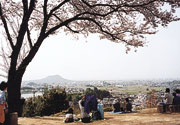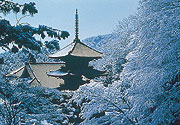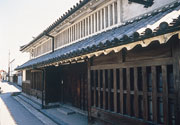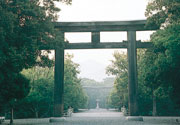 |
 |
| Gives a panoramic
view of the Yamato-Sanzan Mountains |
|
 |
 Amakashi-no-oka
is a hill 148m above sea-level situated at the center of the
Asuka area. From the top of the hill is a panoramic view of
Yamato-Sanzan or the three main mountains of the area, Mt.
Miminashi, Mt. Unebi and Mt. Amanokaguyama. The entire hill
is part of the Asuka Rekishi Park. Planted along the west
ridge of the hill are cherry blossom and plum trees referred
to in the Man'yoshu poetry anthology. Visitors can enjoy beautiful
landscape in spring when all the trees are in full bloom. Amakashi-no-oka
is a hill 148m above sea-level situated at the center of the
Asuka area. From the top of the hill is a panoramic view of
Yamato-Sanzan or the three main mountains of the area, Mt.
Miminashi, Mt. Unebi and Mt. Amanokaguyama. The entire hill
is part of the Asuka Rekishi Park. Planted along the west
ridge of the hill are cherry blossom and plum trees referred
to in the Man'yoshu poetry anthology. Visitors can enjoy beautiful
landscape in spring when all the trees are in full bloom.
 0744-54-2441(Asuka
Management Center) 0744-54-2441(Asuka
Management Center)
 Take
bus No.2 from Kintetsu Kashihara Jingu Mae Station and get
off at Amakashi-no-oka. Take
bus No.2 from Kintetsu Kashihara Jingu Mae Station and get
off at Amakashi-no-oka. |
 |
 |
 As
a divine savior of all the people in the world and a healer
of eye-related diseases, "Juichimen (eleven faced) Kannon"
which has ten faces on the top of its main face, is worshipped
by people who suffer from eye diseases. As acknowledgement
of its long-time medical contribution in helping provide free
medical services to people in India, Tsubosakadera Temple
was given a large "Kannon" statue by the Government of India.
The statue is 20m in height and 1,200t in weight, which is
taller than the Great Image of Buddha in Todaiji Temple by
approx. 3m. As
a divine savior of all the people in the world and a healer
of eye-related diseases, "Juichimen (eleven faced) Kannon"
which has ten faces on the top of its main face, is worshipped
by people who suffer from eye diseases. As acknowledgement
of its long-time medical contribution in helping provide free
medical services to people in India, Tsubosakadera Temple
was given a large "Kannon" statue by the Government of India.
The statue is 20m in height and 1,200t in weight, which is
taller than the Great Image of Buddha in Todaiji Temple by
approx. 3m.
 0744-52-2016
/ 8:30 - 17:00 / Open 7 days a week 0744-52-2016
/ 8:30 - 17:00 / Open 7 days a week
  500 500
 Take bus No. 75, 85 or 221 from Kintetsu Tsubosakayama Station
get off at Tsubosakadera. A 5-minute walk from the bus stop
Take bus No. 75, 85 or 221 from Kintetsu Tsubosakayama Station
get off at Tsubosakadera. A 5-minute walk from the bus stop |
 |
| Well-preserved
old streets of the Edo Period |
|
 |
 Imai
Town is designated as an area for the preservation of traditional
buildings by the central government. About 70% of the houses
were built in the Edo Period (the 17th to 19th century). Imai
Town has been an enthusiastic promoter of the preservation
of the traditional landscape, and what we see now in Imai
Town is the fruit of their efforts in encouraging the coexistence
of the old and the new. Imai Machishu Museum (Hanairaka) displays
precious items and artifacts related to Imai Town. Depending
upon the season, the old houses of Imanishi and Toyota are
open to the public. Imai
Town is designated as an area for the preservation of traditional
buildings by the central government. About 70% of the houses
were built in the Edo Period (the 17th to 19th century). Imai
Town has been an enthusiastic promoter of the preservation
of the traditional landscape, and what we see now in Imai
Town is the fruit of their efforts in encouraging the coexistence
of the old and the new. Imai Machishu Museum (Hanairaka) displays
precious items and artifacts related to Imai Town. Depending
upon the season, the old houses of Imanishi and Toyota are
open to the public.
 0744-22-4001
(Kashihara City Tourist Association) 0744-22-4001
(Kashihara City Tourist Association)
 Admission
Free Admission
Free
 A
5-minute walk from Kintetsu Yagi Nishiguchi Station / A 15-minute
walk from Kintetsu Yamato Yagi Station A
5-minute walk from Kintetsu Yagi Nishiguchi Station / A 15-minute
walk from Kintetsu Yamato Yagi Station |
 |
| A large votive
tablet with Oriental Zodiac animal symbols |
|
 |
 Situated
to the southeast of Mt. Unebi, with a sanctuary area of approx.
500,000 square meters, Kashihara Shrine was established in
1889 based on the description in "Nihonshoki," the chronicle
of Japan. "Shinrin Yuen" which is its park, has some 400 species
of trees and provides a pleasant area for walks. Every year
a large votive tablet with Oriental Zodiac animal symbols
is dedicated to the deity of the shrine. Situated
to the southeast of Mt. Unebi, with a sanctuary area of approx.
500,000 square meters, Kashihara Shrine was established in
1889 based on the description in "Nihonshoki," the chronicle
of Japan. "Shinrin Yuen" which is its park, has some 400 species
of trees and provides a pleasant area for walks. Every year
a large votive tablet with Oriental Zodiac animal symbols
is dedicated to the deity of the shrine.
 0744-22-3271
/ 10:00 - 17:30 (Treasury Museum) /Open 7 days a week 0744-22-3271
/ 10:00 - 17:30 (Treasury Museum) /Open 7 days a week
 Admission
Free (except for the Treasury Museum Admission
Free (except for the Treasury Museum  300) 300)
 A
5-minute walk from Kintetsu Kashihara Jingu Mae Station A
5-minute walk from Kintetsu Kashihara Jingu Mae Station |
|

